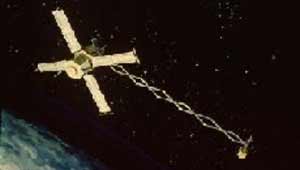
Ulysses is a decommissioned robotic space probe whose primary mission was to orbit the Sun and study it at all latitudes. It was launched in 1990 and made three "fast latitude scans" of the Sun in 1994/1995, 2000/2001, and 2007/2008. In addition, the probe studied several comets. Ulysses was a joint venture of NASA and the European Space Agency (ESA) with participation from Canada's National Research Council. The last day for mission operations on Ulysses was June 30, 2009.

Pioneer 5 was a spin-stabilized space probe in the NASA Pioneer program used to investigate interplanetary space between the orbits of Earth and Venus. It was launched on March 11, 1960 from Cape Canaveral Air Force Station Launch Complex 17A at 13:00:00 UTC with an on-orbit dry mass of 43 kg. It was a 0.66 m diameter sphere with 1.4 m span across its four solar panels and achieved a solar orbit of 0.806 × 0.995 AU.

Pioneer 6, 7, 8, and 9 were space probes in the Pioneer program. They were a series of solar-orbiting, spin-stabilized, solar cell- and battery-powered satellites designed to obtain measurements on a continuing basis of interplanetary phenomena from widely separated points in space. They were also known as Pioneer A, B, C, and D. The fifth was lost in a launch accident, and therefore did not receive a numerical designation.

Nozomi was a planned and launched Mars-orbiting aeronomy probe. It did not reach Mars orbit due to electrical failures. The mission was terminated on December 31, 2003.

Explorer 35 was a spin-stabilized spacecraft instrumented for interplanetary studies, at lunar distances, of the interplanetary plasma, magnetic field, energetic particles, and solar X rays. It was launched into an elliptical lunar orbit. The spin axis direction was nearly perpendicular to the ecliptic plane, and the spin rate was 25.6 rpm. Mission objectives were achieved. After successful operation for 6 years, the spacecraft was turned off on June 24, 1973.

Helios-A and Helios-B are a pair of probes launched into heliocentric orbit for the purpose of studying solar processes. A joint venture of West Germany's space agency DFVLR and NASA, the probes were launched from Cape Canaveral Air Force Station, Florida, on December 10, 1974, and January 15, 1976, respectively. Built by the main contractor Messerschmitt-Bölkow-Blohm, they were the first spaceprobes built outside both the United States and the Soviet Union to leave Earth orbit.

The Magnetospheric Multiscale Mission (MMS) is a NASA robotic space mission to study the Earth's magnetosphere, using four identical spacecraft flying in a tetrahedral formation. The spacecraft were launched on 13 March 2015 at 02:44 UTC. It is designed to gather information about the microphysics of magnetic reconnection, energetic particle acceleration, and turbulence, processes that occur in many astrophysical plasmas.

Magsat spacecraft was launched in the fall of 1979 and ended in the spring of 1980. The mission was to map the Earth's magnetic field, the satellite had two magnetometers. The scalar and vector (fluxgate) magnetometers gave Magsat a capability beyond that of any previous spacecraft. Extended by a telescoping boom, the magnetometers were distanced from the magnetic field created by the satellite and its electronics. The satellite carried two magnetometers, a three-axis fluxgate magnetometer for determining the strength and direction of magnetic fields, and an ion-vapor/vector magnetometer for determining the magnetic field caused by the vector magnetometer itself. MAGSAT is considered to be one of the more important Science/Earth orbiting satellites launched; the data it accumulated is still being used, particularly in linking new satellite data to past observations.

Spacecraft magnetometers are magnetometers used aboard spacecraft and satellites, mostly for scientific investigations, plus attitude sensing. Magnetometers are among the most widely used scientific instruments in exploratory and observation satellites. These instruments were instrumental in mapping the Van Allen radiation belts around Earth after its discovery by Explorer 1, and have detailed the magnetic fields of the Earth, Moon, Sun, Mars, Venus and other planets and moons. There are ongoing missions using magnetometers, including attempts to define the shape and activity of Saturn's core.

Explorer 14 was a spin-stabilized, solar-cell-powered spacecraft instrumented to measure cosmic-ray particles, trapped particles, solar wind protons, and magnetospheric and interplanetary magnetic fields. A 16-channel PFM/PM time-division multiplexed telemeter was used. The time required to sample the 16 channels was 0.323 s. Half of the channels were used to convey eight-level digital information, and the others were used for analog information. During ground processing of the telemetered data, the analog information was digitized with an accuracy of 1/100 of full scale. One analog channel was subcommutated in a 16-frame-long pattern and was used to telemeter spacecraft temperatures, power system voltages, currents, etc. A digital solar aspect sensor measured the spin period and phase, digitized to 0.041 s, and the angle between the spin axis and sun direction to about 3-degree intervals.

Explorer 10 was an American Earth-orbital satellite that investigated Earth's magnetic fields and nearby plasma. Launched on March 25, 1961, it was an early mission in the Explorer program and was the first satellite to measure the "shock wave" generated by a solar flare.

ATS-1 was the first experimental equatorial synchronous satellite. Though intended as a communications satellite rather than as a weather satellite, it carried the Spin Scan Cloud Camera developed by Verner E. Suomi and Robert Parent at the University of Wisconsin. After entering a geostationary orbit at 23,000 mi (37,000 km) above Earth, initially in orbit over Ecuador, it transmitted weather images from the Western Hemisphere, as well as other data, to ground stations, including well as video feeds for television broadcasting. "For the first time," historians would note later, "rapid-imaging of nearly an entire hemisphere was possible. We could watch, fascinated, as storm systems developed and moved and were captured in a time series of images. Today such images are an indispensable part of weather analysis and forecasting."

Magnetometer (MAG) is the name of an instrument suite on the Juno orbiter for planet Jupiter. The MAG instrument includes both the Fluxgate Magnetometer (FGM) and Advanced Stellar Compass (ASC) instruments. There two sets of MAG instrument suites, and they are both positioned on the far end of three solar panel array booms. Each MAG instrument suite observes the same swath of Jupiter, and by having two sets of instruments, determining what signal is from the planet and what is from spacecraft is supported. Avoiding signals from the spacecraft is another reason MAG is placed at the end of the solar panel boom, about 10 m and 12 m away from the central body of the Juno spacecraft.

Explorer 15, also called EPE-C, was an American satellite launched as part of the Explorers program. Explorer 15 was launched on October 27, at Cape Canaveral Air Force Station, Florida, United States, with a Delta rocket.

Explorer 21, also called IMP-B and Interplanetary Monitoring Platform IMP-B, was an American satellite launched as part of Explorers program. Explorer 21 as launched on 27 November 1964 on Cape Canaveral, Florida, United States, with a Delta rocket. Explorer 21 was the second satellite of the Interplanetary Monitoring Platform.

Explorer 22 was an American satellite launched as part of Explorers program of the NASA.

Explorer 43, also called as IMP-I and IMP 6, was a U.S. satellite launched as part of Explorers program. Explorer 43 as launched on March 13, 1971 on Cape Canaveral, with a Delta rocket. Explorer 43 was the sixth satellite of the Interplanetary Monitoring Platform.

Explorer 45 was a NASA satellite launched as part of Explorers program. Explorer 45 as launched on 15 November 1971 from the San Marco platform of the Broglio Space Center, with a Scout rocket. Explorer 45 was the only one to be released from the program Small Scientific Satellite.

Explorer 47, also known IMP-7 and Interplanetary Monitoring Platform IMP-H, was an American satellite launched as part of Explorers program. Explorer 47 as launched on 23 September 1972 on Cape Canaveral, Florida, U.S., with a Delta rocket. Explorer 47 was the seventh satellite of the Interplanetary Monitoring Platform.

Explorer 50, also known as IMP-J or IMP-8, was a NASA satellite launched to study the magnetosphere. It was the eighth and last in a series of the Interplanetary Monitoring Platform.


























